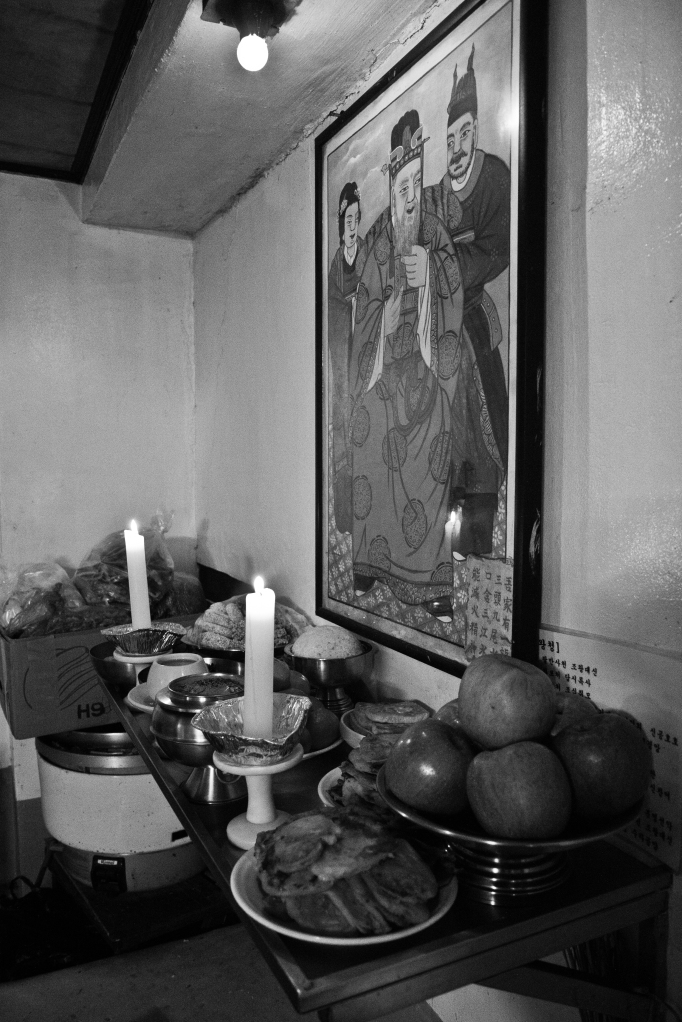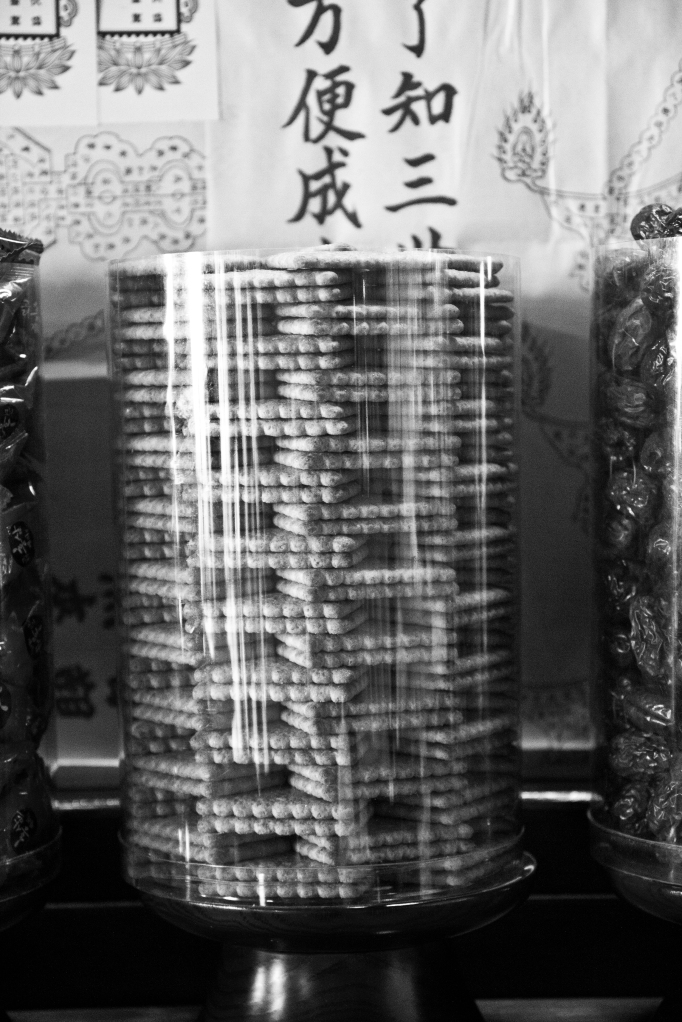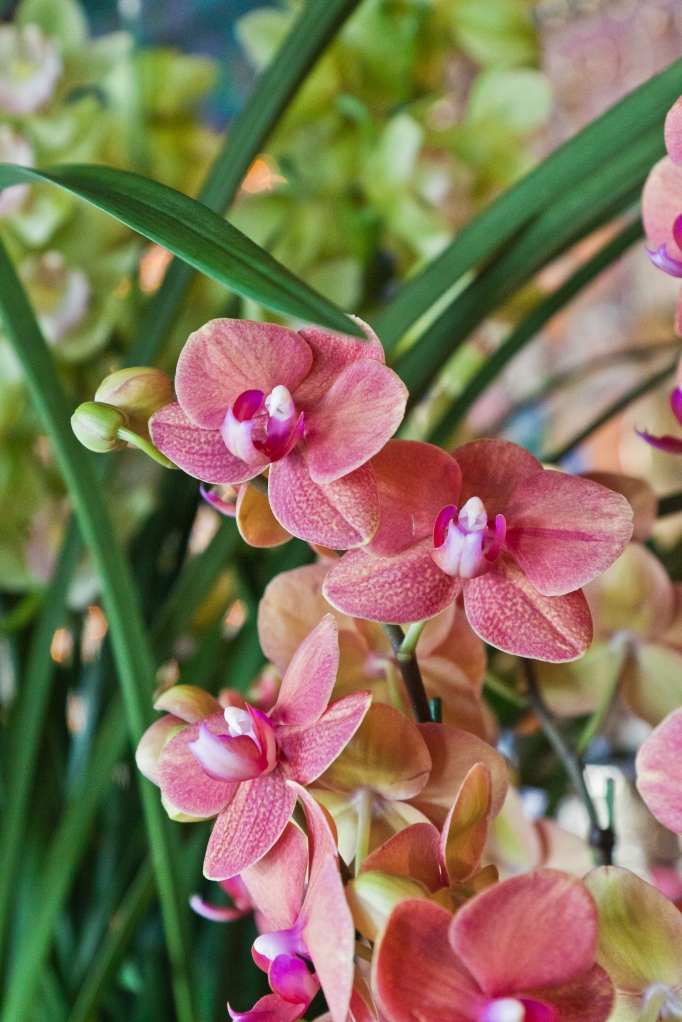each day (new years, ancestors, and confusing chronos)
Fruit and flower offerings on the main altar
The little new year is ending. When it began, I was a seminary student on her last winter solstice vacation, heading from school outside of Daegu to my home temple in North Jeolla Province. Now I am a graduate, at home in North Jeolla, settling with difficulty into the rhythm of a temple that has, in the four years I was away at school, become unfamiliar.
Sunday, we spent the day preparing for the lunar new year’s ceremonies: first, on Sunday afternoon (the 29th day of the 12 lunar month), we made offerings to the Jo Wang Shin, more commonly known as “the Kitchen god,” in our kitchen. On Monday, the first of the new lunar year, immediately following the dawn service, we performed the rice-offering we usually perform at mid-morning, and then made offerings to the ancestors at our memorial altar.
The Jo-wang, or Kitchen God, altar
The memorial altar, with offerings for the ancestors. On the wall are memorial plaques with the names of specific individuals.
One of the first things I had to come to terms with in Korean temples was the presence of the ancestors. Not only the regular performance of memorials for both the recently deceased and ancient forebears, but also the standard inclusion of rituals and ceremonies for the ancestors in every Buddhist ceremony. The Confucian culture and values intertwined with Buddhism in Korea are the reason for this hybrid ceremony and dual metaphysics: A common question non-Koreans often ask is, “If the consciousness leaves the body, enters the bardo, and receives a new body in a new realm of existence after 49 days, what or who on earth is left to be an ancestor in this sense?” It’s not an unfair question, since what happens ritualistically in many of these ceremonies is the appeasement of the family spirits through offerings of both food and Dharma. But who or what needs appeasement and comes to partake, if orthodox Buddhist teaching would suggest this is radically impossible?
Biscuits stacked in the traditional way for offering to the ancestors
No one has offered a suitable answer to this question, at least in the context of those Koreans who are both dedicated Confucianists and devout Buddhists. The silence regarding this question seems akin to Pascal’s wager, except that it wants to have its cake and eat too (just to confuse matters) by wagering on two different metaphysical systems.
Thich Nhat Hanh is one of the few Buddhist teachers to make practices from one culture available to not only a new generation in the same culture, but even accessible for those outside the original culture. This is what he said about ancestors in a public Dharma talk at Pagoda Phat Hue:
In Plum Village, every year, we celebrate one Ancestors’ Day. And during that day we practice looking deeply in order to recognize the presence of our ancestors in us, in every cell of us. We know that our ancestors are our roots. It’s like the plant of corn has a seed of corn as a root, and when you are well rooted, then you are strong. But if you are uprooted, then you are not strong enough to confront life.
That is why in countries like Vietnam, every family has an ancestral alter in the house. Ancestral worship is what we practice. In China, also, we practice ancestor worship.
Even if you are not rich, but in your home there is in a central place, a table or a hallway, create an ancestral altar. You may have an incense bin. You may have a flower pot on the ancestral altar.
When we cry, our ancestors also cry with us. And when we listen to a Dhamma talk, our ancestors also listen to a Dhamma talk. This is really wonderful.
So, the practice is, every day, you go to the ancestral altar, and you remove the dust. You wipe the dust from the altar, you change the water in the flower pot, and you light a stick of incense and put it on the incense burner. That is the way we practice.
And why do we do that? We are getting in touch with our ancestors. It takes only one or two minutes to take care of the ancestral altar, but during the time that we clean the altar, during the time we light a stick of incense, we are really in touch with our ancestors. And we get rooted more deeply in our ancestors. We have the feeling that wherever we go, our ancestors are with us. We don’t feel alone. We don’t feel alienated. That is the goodness with the practice of ancestral worship.
Honoring the ongoing presence of family members in our lives, sidestepping the metaphysics and rituals, grounding the presence of our ancestors in our own flesh and feeling (rather than focusing on an external projection onto offerings, say), is something I can relate to. I’ve held 49-day ceremonies for my grandparents and memorials for our ancestors. I also imagine the day that I’ll finally be able to celebrate a memorial ceremony in an American way: coffee and bread, soup and salsa, cheese and crackers, casseroles and cookies, fruit and vegetables. The things my family likes to eat. If part of the purpose of ceremony is to bridge the unspeakable spaces between realms, we need to have a ceremony that reflects the realm we stand in, including the offerings. Even if you follow orthodox Buddhist teachings on the consciousness and reject the notion that the family spirits come to dine, I find little to argue with a kind of Buddhist wake, a celebration of the connection between generations which Thich Nhat Hanh so beautifully emphasizes.
Orchids offered on the main Buddha altar
Despite my different perspective on remembering ancestors, and my yearning to modify the memorial ceremonies to reflect the culture I come from, I value the way that such constant interaction with the ancestors breaks the finality of death. If the ancestors can be invited to come and dine with us, then they haven’t finally departed. They abide, and, in the Korean world, interact with us. The metaphysics of such continuance and interaction may not hold for the nitpicky Buddhist, but the emotional impact of having ancestors always responsive to us and our lives is certain.
I’ve grown away from seeking definitive ends and beginnings to things over the years since I first entered the temple. About seven and a half years ago, I was convinced that simply by shaving my head, changing my daily schedule, and receiving precepts, a corresponding inner metamorphosis would happen with the same immediately visible or tangible shift as a haircut or a ceremony. My experience has been that those internal metamorphoses are, at best, slow and circular. They seem to proceed forward only to return to a point near where they began. They do not track with chronos, and seem to function at times in direct defiance of the forward-march of a timeline. There are times of deep disjoint, when the exterior symbols don’t match the interior state, and I feel like I’ve failed to be what I present as. The gap between sign and content encourages flexibility when approaching the world; after all, who knows what’s gestating in the unseen spaces of the heart? Who knows what might emerge to break with what we expected at first glance, and shock us into letting go of our ideas?
I’m drawn to “the little new year” between winter solstice and lunar new year because it diffuses the impact of a single day over a month, confusing the meaning of renewal we usually assign to “the new year.” If there’s no one “new year,” then maybe there is no one “new beginning.” These ceremonies for the ancestors diffuse death in a similar way. We are instructed to say goodbye, even given forty-nine days to do it, and allowed our grief; then told to let the departed leave. But then, with regularity, we are told to approach the departed, that they are returned to us and with us (however we chose to understand or experience that return), and we are encouraged to sit with them, remember them, honor them, and that most basic material expression of love, to feed them.
Whichever new year you celebrate (the Tibetan New Year, Losar, is coming up on the 22nd), may each day be filled with all the potential that new beginnings have, and may you and yours throughout the generations enjoy the blessings of health, contentment, peace, and joy this and every year.
Self-portrait in offering bowl
School confronts me with the endless challenge of living amongst many, many others; the Sino-Korean for “community” is, literally, “a great gathering (大衆).” In physical terms, this has meant three years of cramming 38 people into spaces that, by Western standards, are suitable for a small gathering of only a fraction the size. The bending of conventional physical limits, however, is not nearly as interesting as having, every day, 37 other faces to study and capture, as possible, with a camera. Even before I tried to take pictures of temple life, I knew that nothing ever really changes in the temple. Each day’s routine follows, roughly, yesterday’s; the calendar year spins on its axis, passing through the seasons much as it did the year before, with rituals and observances carrying over time, knitting the oldest and youngest in the community together by the transmission and exercise of these cycles, daily, monthly, yearly. If you want variation, you have only two places to look: the chaos inside, as you respond differently to the same things, and outside, as those around you respond differently to the same things. From an artistic standpoint, then, portraits become one of the few captivating aspects of temple life, because even when swinging through their own cycles, those around you do it in such charming, hilarious, pitiable, sympathetic, wretched, outraged, lovely, and ugly ways. In short, they are human. And we have always been fascinated by ourselves and our emotions.
But now it’s vacation, and at the home temple, we are not so many as forty. Four, often, is everyone. Additionally, of those four, half are senior nuns, and senior nuns are notoriously camera-shy. I am notoriously camera-shy. In an empty Dharma Hall after the mid-morning offering service, even the light–one of the other captivating aspects of temple life–has stopped its dramatics and the Hall is plaintive, dim, and silent. Peering at the altar objects, thinking to make a still-life, someone peered back at me.
As I said, if you want variation, you have only two things to look at: the others around you, or yourself.
Relief Matrix
Woodblock print edition of the Awakening of Faith in the Mahayana.
For more on woodblock printing (which uses a technique known as a relief matrix), see Wikipedia.








